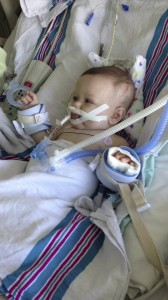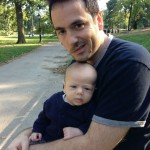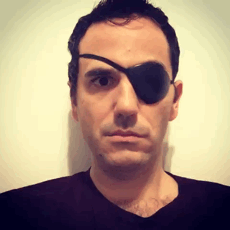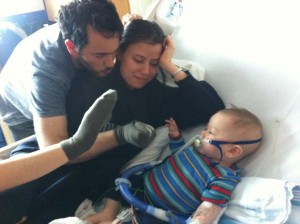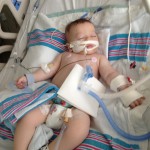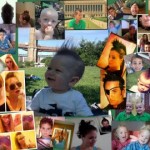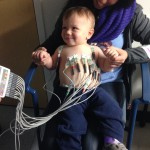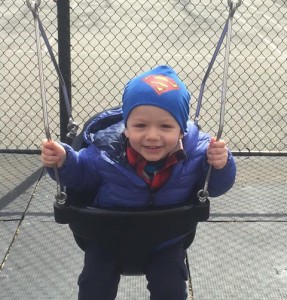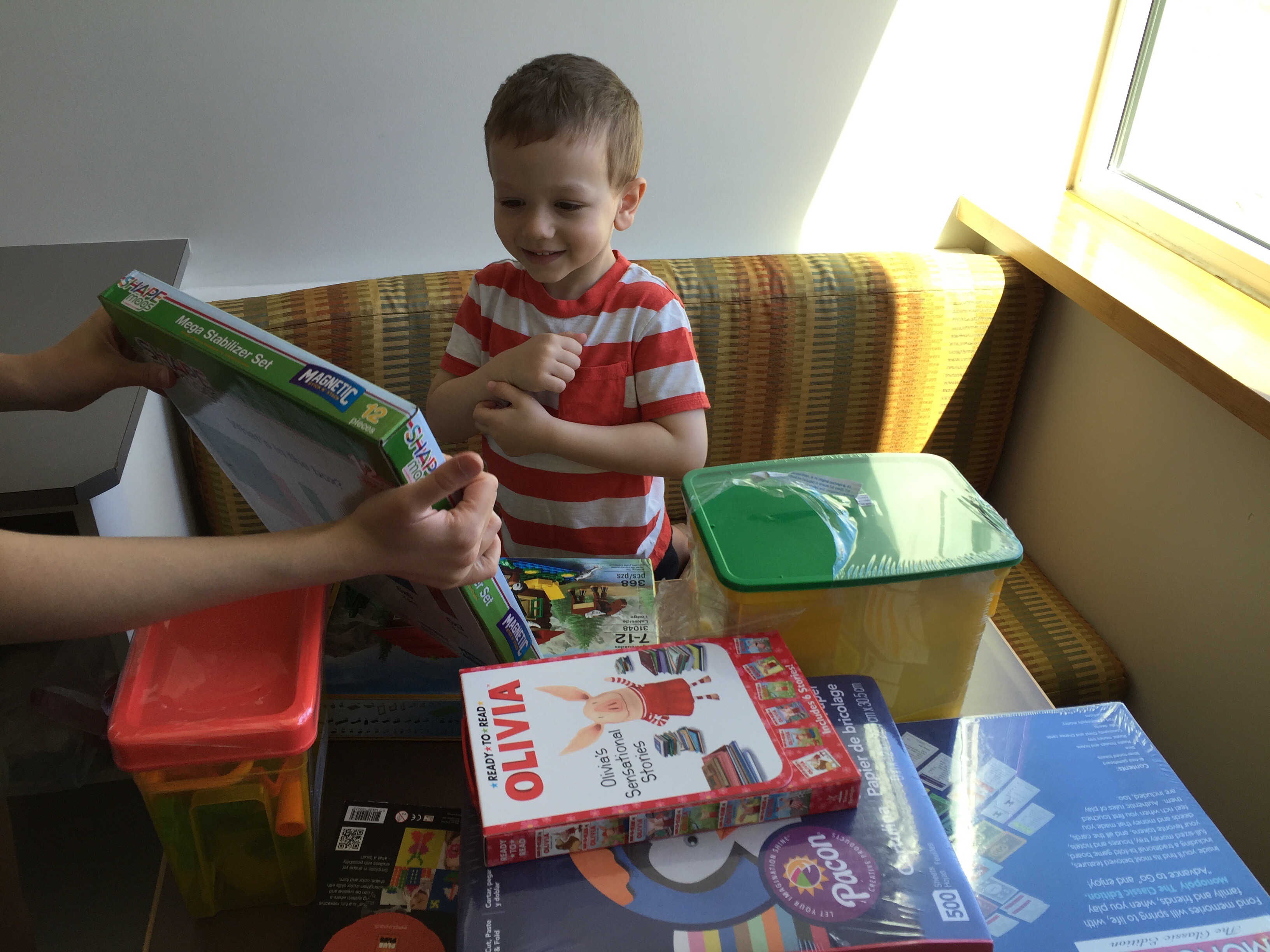
Our first full day in Seattle and we are getting used to our temporary living situation (SCCA House) and getting reacquainted with Seattle. Our appointments start on Wednesday. As before, the Seattle community has been so amazingly welcoming and have gone out of their way to help us get acclimated (including lending us a car to get around while we’re here). One very special 12 year old has organized for all her friends, as part of her Bat Mitzvah cause, to get Idan new toys and activities to keep him busy during the long days ahead. Below is just the first batch of many amazing toys she has organized for Idan. We are so thankful too her and the many that have donated these items to bringing a smile to Idan’s face and keep him busy.
Tag: CD40 Ligand Deficiency
Idan's Blog
Dream a Little Dream
by Amanda • • 4 Comments
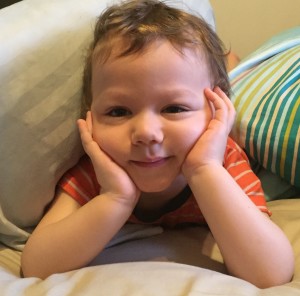 Ever get that feeling, towards the end of an intense dream, that things all of a sudden start malfunctioning or, even weirder, morph into something else? Where all of a sudden, despite passively accepting all of the nonsensical parts of the dream when it first began, you become aware of the illusion? Reality seeps in, and you open your eyes. Maybe sunlight washes over you, maybe the buzz of the alarm shocks you into motion, or maybe it’s the sound of a baby’s cry that gets your feet planted on the ground.
Ever get that feeling, towards the end of an intense dream, that things all of a sudden start malfunctioning or, even weirder, morph into something else? Where all of a sudden, despite passively accepting all of the nonsensical parts of the dream when it first began, you become aware of the illusion? Reality seeps in, and you open your eyes. Maybe sunlight washes over you, maybe the buzz of the alarm shocks you into motion, or maybe it’s the sound of a baby’s cry that gets your feet planted on the ground.
Sometimes this is comforting, no? Sometimes you fall into a deep sleep, and the dreams are frightening. They show you a world where you are alone, fighting, struggling, running. The moment where the illusion ends is met with a sigh of relief – everything is okay, you’re awake now.
Sometimes it is the opposite, though. The dream – the illusion – is a sanctuary against reality. A peaceful interlude that gives you a break from the chaos.
The other night, I had a dream that I was living in a small claustrophobic room, and directly above my head, there was a hole in the ceiling where I could see trucks and cars passing right over us. Mindy Kaling from The Mindy Project was asleep on the floor to my right (like I said, nonsensical), and seemed blissfully unaware that we were living right under a highway, and that there was no way out except to climb out of this hole and risk being run over. As I was plotting our escape, trying to figure out how fast we needed to climb out of the hole and dart across the highway in between the cars zipping by to get to safety on the other side, the walls started morphing, and suddenly our little bunker turned into the back of a truck. Someone else was driving the truck, and Mindy and I were still in the back, this time being jostled back and forth, not knowing where we were going. At this point, the illusion started to fade. I could believe Mindy sleeping on the floor of my underground bunker, but I could not believe that the bunker had turned into a truck. Reality began to seep in, and I woke up.
I was relieved to be awake. The sun was shining right through the window, Akiva was sleeping peacefully next to me, and Idan was in the other room, beginning his morning ritual of sweetly talking to himself until either I or Akiva came in to greet him.
I was relieved to be awake, but had I really woken into reality? Isn’t our life here, in a way, an illusion? A peaceful interlude before the chaos of transplant? The whirlwind hospital days and pre-testing leading up to admission, the unpredictable but inevitable events and incidents post-transplant, the constant trips back and forth to the clinic, the pharmacy, and the hospital, and the gargantuan efforts required to turn the whole trip into an adventure, yet still maintaining some semblance of normalcy, for Idani as every little fiber of his being is tested and challenged… isn’t that reality?
This week, our home appliances have been taking the biggest hit, each of them taking turns malfunctioning. The illusion of our peaceful life here is slowly being peeled away, and, come Sunday afternoon, we’ll be jerked into reality. Maybe it will be the Seattle skyline washed in sunlight, or maybe the wheels touching the ground that shock us into motion, or maybe Idan’s voice sweetly talking to himself as he gazes out the window of the airplane, but we’ll open our eyes, and the illusion will be over.
I don’t know how I’ll feel when I wake up from this particular dream. I don’t know if I’ll be relieved to be taking our first step towards the end of a horrible nightmare, or if the fear and chaos of transplant will be overwhelming. But I do know that, as long as Akiva and Idan are by my side, I am ready to wake up.
Idan's Blog
Update on Idan’s 2nd transplant and the Foundation
by Admin • • 0 Comments
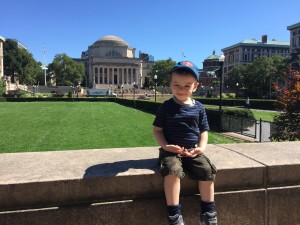 Three years ago when our baby boy Idan was diagnosed with Hyper IgM Syndrome (HIGM), a rare and life-threatening immune deficiency, an army of supporters came together to support Idan and our family as we headed into a bone marrow transplant to cure our little boy. Although the transplant was unsuccessful, something unique and special came out of that first battle: the Hyper IgM Foundation. As Amanda and I immersed ourselves in everything Hyper IgM in order to find a cure for Idan, we learned of the dire need for a community and voice for the Hyper IgM patients around the globe. HIGM is rare among an already rare family of genetic diseases categorized as primary immune deficiencies. The little information we could find tended to be outdated or inaccurate. We set out to not only fix this but to gather patients and families from around the world to create a stronger voice for Hyper IgM Syndrome patients in hopes that a combination of advocacy, education, and focused research will accelerate a cure and better outcomes for all families with Hyper IgM.
Three years ago when our baby boy Idan was diagnosed with Hyper IgM Syndrome (HIGM), a rare and life-threatening immune deficiency, an army of supporters came together to support Idan and our family as we headed into a bone marrow transplant to cure our little boy. Although the transplant was unsuccessful, something unique and special came out of that first battle: the Hyper IgM Foundation. As Amanda and I immersed ourselves in everything Hyper IgM in order to find a cure for Idan, we learned of the dire need for a community and voice for the Hyper IgM patients around the globe. HIGM is rare among an already rare family of genetic diseases categorized as primary immune deficiencies. The little information we could find tended to be outdated or inaccurate. We set out to not only fix this but to gather patients and families from around the world to create a stronger voice for Hyper IgM Syndrome patients in hopes that a combination of advocacy, education, and focused research will accelerate a cure and better outcomes for all families with Hyper IgM.
Three years later, we are going into battle again for our little boy, and behind us, we hope, stands the same army that helped us in our original fight. As we head back to Seattle for Idan’s 2nd transplant, we are calling on you to help not only us, but to help all children with Hyper IgM Syndrome. Idan is one of the lucky ones, he has several matched donor options for a transplant, but for many others transplant is not possible. And the cure itself comes with significant risks, with transplant complications taking the lives of two other little boys with Hyper IgM in the month of May alone. Our goal is to raise funds for research into gene therapy and other techniques that can provide curative options for all HIGM patients.
The Hyper IgM Foundation aims to improve outcomes and quality of life for Hyper IgM patients and their families through promoting and supporting research, creating and providing educational tools for the patient and physician communities, and creating a community to support Hyper IgM patients and their families as they undergo treatment and cope with this disease. Between Akiva’s extensive experience in public health, Amanda’s legal background in healthcare and nonprofit law, our fellow board member Dr. David Hagin’s cutting-edge research into gene editing for Hyper IgM, and our scientific advisory committee that consists of the foremost experts on Hyper IgM in the world, we are confident that we can make a tremendous impact.
We hope you can join us again in support for a cause that will impact the lives of many children and adults living with HIGM.
For those of you interested in following Idan’s journey, we will be updating Idan’s blog and Facebook page on a regular basis. We are heading back to Seattle on June 19, and expect to be admitted to Seattle Children’s Hospital in July for 4-6 weeks. For the second time, we’re packing our bags and uprooting our lives. The decision to move forward with a second transplant was even more difficult than the first time, knowing what we do now about the risks of transplant, but we have to believe that Idan will be cured, and that he will have a brighter future.
—–
The Hyper IgM Foundation is a recognized 501(c)(3) charity and all donations are tax deductible. We thank you for your support and invite you to stay up-to-date on the Foundation’s efforts by connecting with us on Facebook by liking the Hyper IgM Foundation Facebook page, www.FB.com/HyperIgMFoundation, and by visiting our website, www.hyperigm.org.
As a reminder, the Hyper IgM Foundation is entirely a volunteer run organization. We have no salaries, no rent and limited overhead. This means that 100% of your donation goes to fulfill our mission to improve the treatment, quality of life and the long term outlook for children and adults living with Hyper IGM Syndrome through research, support, education, and advocacy.
Idan's Blog
If at first you don’t succeed, try, try, try again.
by Amanda • • 8 Comments
 I’ve been holding my breath. Waiting for our lives to change course, waiting for a miracle. Hoping, wishing… dreading. The past three years, we have been in limbo. A cycle of joy and devastation that seems to be in an unending loop. If you’ve been following our story, you know that we had a flicker of hope that Idan’s first bone marrow transplant may have worked just enough to afford him with some immune function that could enable him to live a mostly normal life. After two trips to North Carolina, multiple blood tests, and months of waiting, we’ve received the test results. Idan does not have immune protection, and does need a second bone marrow transplant.
I’ve been holding my breath. Waiting for our lives to change course, waiting for a miracle. Hoping, wishing… dreading. The past three years, we have been in limbo. A cycle of joy and devastation that seems to be in an unending loop. If you’ve been following our story, you know that we had a flicker of hope that Idan’s first bone marrow transplant may have worked just enough to afford him with some immune function that could enable him to live a mostly normal life. After two trips to North Carolina, multiple blood tests, and months of waiting, we’ve received the test results. Idan does not have immune protection, and does need a second bone marrow transplant.
It’s official: we are going back to Seattle to save Idan, with the hope that a new donor and a more aggressive approach will result in a cure once and for all.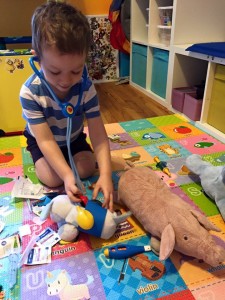
Things will be different this time. Idan will be nearly 4 years old. He is a curious and insightful child. Questions like “when will I go to a school outside” and “why don’t I have friends” are trickling in now, so it’s hard to imagine what kinds of questions will race through his inquisitive mind as we take him for one test after another, put him through surgery to stick a tube into his body that will become a permanent fixture during his stay in Seattle, confine him to a hospital room for 30 days, give him chemo that will turn his stomach and make him lose all his hair. Rip him from his home, his grandparents, aunts, uncles and cousins, his teacher, his babysitters, everything he knows and finds familiar. What questions will run though his inquisitive mind.
Akiva reassured me, “he’s still the same Idan.” And he’s absolutely right. Idan is incredibly strong, resilient, unstoppable, and turns every challenge into a game. In the past few months alone, Idan has learned to read, can add and subtract double-digit numbers, easily counts to 1,000 by himself, and can tell time using a roman numeral clock. He tells jokes, makes funny faces, loves to play doctor, pilot, and board games. He still loves to paint and joyously tackles the most intricate of Lego models. He genuinely loves life, and he is full of boundless energy.
All of these character traits will be tools for him during transplant. His obsession with numbers will mean that, when the nurse is taking his blood pressure with the cuff that squeezes too tightly, he’ll be too busy watching the numbers change on the monitor to mind the discomfort. His joy for playing doctor and connecting vials to syringes (thank you Baxter for the toy IVIG kit) will mean that he will be excited to watch how his central line connects to the syringes and IV tubes, so maybe he won’t be so bothered by being tethered to Johnny Five (his IV pole). His ability to turn even the most mundane things (“Mommy, let’s talk about what’s in the closet!”) into games will help us pass the long days tied to a bed in the hospital.
And, perhaps most importantly, every minute will be spent with the two people in this world that love him the most, a rare and precious gift that we do not take for granted.
So yes, transplant, especially the second time around, is scary and comes with the very risks that make up a parent’s worst nightmare, but Idan is strong, Akiva and I will be there to hold his hand and carry him through it all. We will keep him smiling that brilliant smile, and fight with him for a better future.
Idan's Blog
One Hundred Voices
by Amanda • • 5 Comments
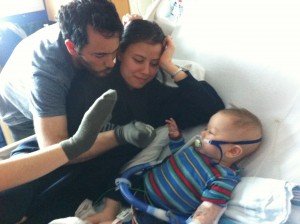
Today marks the third anniversary since that fateful trip to the ER. The very first sign we had that our world would come crashing down. I remember our silent speedy march to the pediatrician’s office that morning. The devastating news that Idan would need to be transported to the ER, immediately, because he wasn’t getting enough oxygen. The fights with the doctors to allow us to feed him, with a burning feeling in the pits of both Akiva’s and my stomachs, knowing that his condition was deteriorating right before our eyes. It’s an indescribable feeling to watch your baby be poked, prodded, and struggling to breathe. To know that the next breath could be his last.
When we walked into the hospital that day, we stepped into a vortex. An unfamiliar and unfriendly world. We were terrified beyond belief, and drew strength and courage from the one person who seemed to have more than any of us put together – Idan. It astounds us to this day that, despite tubes down his throat, in his nose, IVs in both arms and legs, restraints on his wrists tethering him to a grown-up size bed, surrounded by strangers and loved ones wearing masks and yellow gowns, despite all that, his little fingers curled around the little caterpillar his grandparents gave him, and his eyes shone bright, and he smiled and giggled. We turned on the music and danced in his room. We did puppet shows and read books, we even introduced him to Sesame Street (all the rules about screen time seemed to fly out the window). Three weeks spent in the pediatric ICU, and Idan fought off PCP – a pneumonia that threatened to take his very life.You all know how the story goes by now… We emerged from the hospital to discover that his pneumonia was simply the introduction to an even scarier world: the world of Hyper IgM.
When we started this journey, we felt so alone. The disease was so rare, and there was no simple way to reach others who had it. That all has changed.
After three years, we have built an army of other parents, patients, and physicians who know all about Hyper IgM. We receive messages and emails on a weekly basis, introducing us to a newly diagnosed family, or patients who have lived with the disease for decades.
Earlier this week, we spoke to a mom of nine children who shared her story with us. Five boys born with Hyper IgM. Three of them passed away much too soon. Two days later, we were contacted by a family who, like us, rushed their son to the ER because of PCP. And that same week, a family from South Korea, who found the Hyper IgM Foundation’s website and expressed such gratitude that, after so long of fighting this disease on their own, finally they were connected to a community of others facing the same challenges they do on a daily basis. When these families were introduced to the Hyper IgM community we founded a couple years ago with the few other families we had been fortunate enough to meet, the response was overwhelming – as it always is. Dozens of comments of welcome, advice, and support. I read the comments on my way home from work, and burst into tears.
Yes, we were so alone once. As were all of these families living in different corners of the world. New York, Louisiana, Ohio, Florida, Texas, Illinois, Canada, Australia, New Zealand, England, the UK, Romania, South Korea – just to name a few. We have all joined hands, and all of a sudden, one voice was replaced by one hundred voices. We have supported each other through bone marrow transplants, infections, even cancer and death. We are not alone anymore.
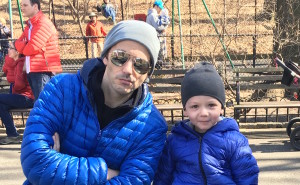 For the past three years, we have spent every free moment becoming experts on Hyper IgM, consulting with the world’s foremost immunologists and transplant teams, attending conferences and meeting families living with the disease. Last year, we formed the Hyper IgM Foundation to improve the quality of life and longterm outlook of patients with Hyper IgM, and we have been so grateful for the outpouring of support we have received. We are already accomplishing our mission, which is in large part due to the tireless efforts of Akiva, who has spent every waking minute working closely with families, physicians, and other immune deficiency networks and foundations. We have found friends and allies in physicians around the world who volunteer their time to consult with parents about treatment options and frequently lend their wisdom to answer questions raised by members of our community. Because of the work of the Foundation, there is now heightened attention on critical research that needs to be done to understand more about this rare and tricky disease. So not only are Akiva, Idan and I not alone anymore, no one with Hyper IgM has to feel alone – ever again.
For the past three years, we have spent every free moment becoming experts on Hyper IgM, consulting with the world’s foremost immunologists and transplant teams, attending conferences and meeting families living with the disease. Last year, we formed the Hyper IgM Foundation to improve the quality of life and longterm outlook of patients with Hyper IgM, and we have been so grateful for the outpouring of support we have received. We are already accomplishing our mission, which is in large part due to the tireless efforts of Akiva, who has spent every waking minute working closely with families, physicians, and other immune deficiency networks and foundations. We have found friends and allies in physicians around the world who volunteer their time to consult with parents about treatment options and frequently lend their wisdom to answer questions raised by members of our community. Because of the work of the Foundation, there is now heightened attention on critical research that needs to be done to understand more about this rare and tricky disease. So not only are Akiva, Idan and I not alone anymore, no one with Hyper IgM has to feel alone – ever again.
Idan's Blog
The Return to Duke
by Amanda • • 10 Comments
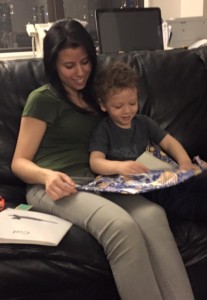 This week we are celebrating the Jewish holiday of Chanukah, which celebrates (among other things) a miracle: After destruction of the temple, the Jews used the last remaining oil they had left to light the menorah, with the flame rising from the menorah in the midst of ruins as a symbol of their resilience despite great hardship and against all odds. They believed the oil would last only one day, but it lasted eight days. To this day, Jews light candles on menorahs around the world for eight days to commemorate this miracle of survival, resilience, and another seven days of light.
This week we are celebrating the Jewish holiday of Chanukah, which celebrates (among other things) a miracle: After destruction of the temple, the Jews used the last remaining oil they had left to light the menorah, with the flame rising from the menorah in the midst of ruins as a symbol of their resilience despite great hardship and against all odds. They believed the oil would last only one day, but it lasted eight days. To this day, Jews light candles on menorahs around the world for eight days to commemorate this miracle of survival, resilience, and another seven days of light.
On the 8th and last day of Chanukah, by coincidence, we are headed to Duke to test whether Idan’s remaining donor t-cells, which are so few in number but are nonetheless hanging on, are, like the oil, sufficient. This would be a miracle indeed.
As we mentioned in our last update in September, we are working with our medical team to plan Idan’s second transplant. As time goes by, it looks more and more likely that we will be heading back to Seattle this Spring for transplant. Idan has been doing great, growing and thriving and we have been able to keep him healthy with his weekly infusions of antibodies. He receives home-school services from the New York State Board of Education, and has been learning to read quite impressively for a 3 yr old (we kid you not). So we are once again headed towards transplant with a healthy, active child, and we are once again gearing up for all the challenges that lie ahead.
Before we decide whether to move forward with a second transplant, however, we need to first conclusively determine that it is absolutely necessary. While he has lost almost all his donor graft, there is around 8-10% of the donor’s t-cells still showing up in his chimerism tests. Although in a perfect world, 10% donor t-cells could in theory be sufficient to provide an individual with a functioning immune system, it appears that the donor t-cells in Idan’s graft are not binding to the B-cells, which is necessary in order to create an antibody response. For this reason, we assume that a 2nd transplant is imminent. However, the tests that have been run so far are not 100% conclusive, and, before going into a second bone marrow transplant, which is without a doubt a life-threatening procedure, we and our team of doctors feel that we need to be absolutely sure that the remaining donor cells lingering in Idan are in fact insufficient to provide Idan with a functioning immune system.
It is not easy to determine whether Idan can make antibodies with the small amount of donor cells left. He receives weekly infusions of subcutaneous immunoglobulins (SCIG), which provides him with a high level of antibodies. One way to test if he can create antibodies is to give him a vaccine (any of those childhood vaccines we all get). However, because of the constant infusion of antibodies through SCIG, he has a full repertoire of antibodies for almost any vaccine, meaning we would not be able to determine whether he was responding to the vaccine or whether the antibody is from the SCIG.
There is one test that is only available in the United States in Seattle and at Duke called the bacteriophage φX174 or Phage. Essentially we would be giving Idan a *fake* vaccine (through an IV) that contains a small amount of a virus that is used to fight bacterial infections. This is not a virus that people are exposed to, and it is not part of vaccinations anyone gets, so antibodies to this virus would not exist in the SCIG he receives weekly. If Idan can make a response to this vaccine, it will show up as distinct immunoglobulin (antibodies) for this phage and can be measured.
After much research and debate we decided to head down to Duke to do this test. It is a short 24 hour visit, and we will send blood samples back to Duke over the next 6 weeks. Then we will head to Duke again in late January for a 2nd dose and repeat blood tests back in NYC. Sometime in March, Duke will send all the samples to Seattle’s immunology lab for testing and we should get results right before the tentative date of the 2nd planned transplant.
Two and a half years after our first expedition to Duke to find a cure for Idan, we are headed back to Duke this Sunday to test if Idan might perhaps be cured. Based on all lab tests it is very unlikely that Idan will make a response to this vaccine. But, if by some miracle his small percentage of donor T-cells can make a response, this might mean that we can postpone 2nd transplant and see if his donor cells can provide him with enough immune function on its own.
We will begin this test on the 8th day of Chanukah, a holiday commemorating that miracle long ago whereby a very small amount of substance that should have lasted only for 1 day lit the Menorah in the temple for 8 full days. Let’s hope that Idan’s small amount of donor cells can pull off the same kind of miracle.
Idan's Blog
Smile – Ten Years Brain Tumor Free
by Akiva • • 2 Comments
“Based on the rate of growth and the location of your tumor you have around two years to live.” That was the sad prediction I heard from dozens of physicians in the summer of 2005. From New York to Boston to Los Angeles and Jerusalem, everyone around the world we consulted had a different approach, but they all agreed: The brain tumor was “inoperable.” I was twenty five years old and one year away from graduating Columbia University. I was way too young to die.
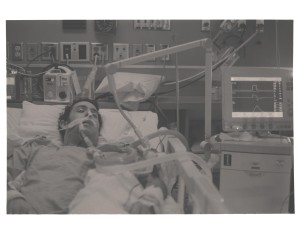 I am still here. Ten years later, I am alive and well and tumor free and the only prediction that came true was the one given by Dr. Robert Spetzler in Phoenix, Arizona. With a big smile on his face he said: “I am 95% confident I can get your whole tumor out, and leave you in not much worse condition than you are now.” At first, it seemed his proclamation might have been an overstatement. On November 8, 2005, Dr. Spetzler successfully remove my whole tumor. While my family was assured the next day that the tumor was all out, and I would be fine, at the time it did not look like it. I was in an induced coma, intubated and had tubes sticking in and out all over my body. I only woke up four days later, when they were finally able to extubate me. I could not feel or move the left side of my body. I could not talk, walk, swallow or do much of anything. The right side of my face was paralyzed and numb, and I could not smile or even hold water in my mouth without it dripping out. Like a newborn baby, I was cradled and tended to by my family and an amazing team of nurses at St. Joseph’s Hospital in Phoenix. Every day Dr. Spetzler came by during rounds, looked at my broken and weak body, and proclaimed, “he is doing great!” Everything will be okay. Eleven days later, I was transferred by plane and wheelchair to NYC to Rusk Rehabilitation Center for what we were told would be a very slow and long process of rehab. There, I learned to walk, talk, swallow and was able to be released to outpatient in three weeks. I continued my rehabilitation out-patient while I resumed classes at Columbia. The right side of my face was paralyzed, and numb, and I had set a personal goal to smile once again.
I am still here. Ten years later, I am alive and well and tumor free and the only prediction that came true was the one given by Dr. Robert Spetzler in Phoenix, Arizona. With a big smile on his face he said: “I am 95% confident I can get your whole tumor out, and leave you in not much worse condition than you are now.” At first, it seemed his proclamation might have been an overstatement. On November 8, 2005, Dr. Spetzler successfully remove my whole tumor. While my family was assured the next day that the tumor was all out, and I would be fine, at the time it did not look like it. I was in an induced coma, intubated and had tubes sticking in and out all over my body. I only woke up four days later, when they were finally able to extubate me. I could not feel or move the left side of my body. I could not talk, walk, swallow or do much of anything. The right side of my face was paralyzed and numb, and I could not smile or even hold water in my mouth without it dripping out. Like a newborn baby, I was cradled and tended to by my family and an amazing team of nurses at St. Joseph’s Hospital in Phoenix. Every day Dr. Spetzler came by during rounds, looked at my broken and weak body, and proclaimed, “he is doing great!” Everything will be okay. Eleven days later, I was transferred by plane and wheelchair to NYC to Rusk Rehabilitation Center for what we were told would be a very slow and long process of rehab. There, I learned to walk, talk, swallow and was able to be released to outpatient in three weeks. I continued my rehabilitation out-patient while I resumed classes at Columbia. The right side of my face was paralyzed, and numb, and I had set a personal goal to smile once again.
 Two years later, in November 2007, I had my diploma from Columbia and went on to obtain an MPH at the Mailman School of Public Health. I was dating the love of my life and was doing great, physically and professionally. But I still could not smile. Sure, I could mostly drink without spilling water out of the side of my mouth, and I had even perfected a method of blowing up balloons. But I had not reached my goal. The cranial nerve that controlled my face was cut or damaged and was not coming back. The doctors had told me over and over again: most deficit improvement is seen in the first 3-6 months. After that, some might still get better in the first 2 years post surgery. But after those two years, things will not improve or come back. My fate was sealed. I may have been reborn as the superhero, iPatchman, but I was destined to always be defeated by DC Comics’ Two-Face.
Two years later, in November 2007, I had my diploma from Columbia and went on to obtain an MPH at the Mailman School of Public Health. I was dating the love of my life and was doing great, physically and professionally. But I still could not smile. Sure, I could mostly drink without spilling water out of the side of my mouth, and I had even perfected a method of blowing up balloons. But I had not reached my goal. The cranial nerve that controlled my face was cut or damaged and was not coming back. The doctors had told me over and over again: most deficit improvement is seen in the first 3-6 months. After that, some might still get better in the first 2 years post surgery. But after those two years, things will not improve or come back. My fate was sealed. I may have been reborn as the superhero, iPatchman, but I was destined to always be defeated by DC Comics’ Two-Face.
Two years later, November 2009, marked some of the happiest days of my life. I just married my true love. I had a dream job in healthcare consulting and life was good. I had outlived all predictions and was tumor free for four years. And despite the utter joy, I could not fully smile. I had perfected the Zoolander Blue Steel look for photos. My wife, Amanda had fallen in love with my half grin and I could not complain. Most people in my situation did not live to tell the tale, and I was complaining about a smile? I continued to refuse offers to surgically stitch my face in a permanent Joker grin and continued my own physical therapy and exercise to keep the little muscle tone I had on my right side of my face.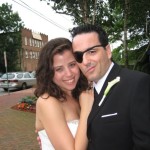
Two years later, in November 2011, now six years post-brain surgery, I sat at Nonna’s Italian Restaurant on the Upper West Side for my birthday dinner with Amanda. She handed me my birthday present. A little red box with yellow teddy bears. Inside, little baby booties and a handwritten note on tissue paper, with the message “To the greatest love we will ever know.” She was informing me that she was expecting. We were going to have a baby in eight months. Inside, my joy was endless, and yet I still could not smile. Just my regular half grin in response to the best news anyone can get.
Two years later, by November 2013, we had experienced both extremes of any parents’ emotional spectrum. From the new happiest day of my life, the day my son Idan was born, to the scariest and saddest day of our life, the day he was intubated for PCP pneumonia. Even if I wanted to smile, I could not. We were filled of hope now, and longing for a normal life again. Just a few weeks after Idan’s bone marrow transplant, I celebrated my 8th year tumor free. I was full of hope that by my ten-year anniversary Idan would be cured and everything will be back to normal. I stopped believing that I would ever smile fully again, even if I wanted to.
Today, two years later, Idan is not cured. We are heading towards a second bone marrow transplant in the spring, and life might never be normal. But hope is still part of every drop of my being. The same unrelenting perseverance that allowed me to live through an inoperable brain surgery has kept my son alive and well and found him the best care he could receive. My education, life experience and optimism serve me now as the president and co-founder of the Hyper IgM Foundation. Our mission is not only to cure Idan, but to work for a cure for all families and children living with Hyper IgM. I know this can be achieved. I know happiness is possible. I know normality is a state of mind. I know all this because I spend the day smiling. A full smile. I spend the day smiling when Idan wakes up in the morning with a million questions as if the night was just a fleeting moment. I spend the day smiling when I see Idan play with his little cousin and they both laugh uncontrollably. And I spend the day smiling when Idan is solving puzzles way too advanced for his age or building lego sets made for six-year olds.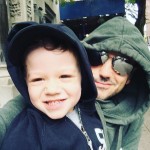
Sometime, over the last two years of trying to achieve normality in a post transplant world, my smile just appeared. Despite all medical predictions of how or when deficits can recover, I am able to smile with both sides of my face now. Ten years, brain tumor free, and I am smiling every morning when I wake up next to Amanda and when Idan calls us into his room. If my smile can appear again ten years after it was removed along with a tumor that had my name on it, I know that anything is possible. I invite you all to help me make that which is impossible a reality. Help me bring a smile to the families across the world dealing with Hyper IgM Syndrome.
Donate today to my ten year brain-tumor-free fundraising page!
Facebook, Idan's Blog
Idan’s Two Year Transplantaversary
by Admin • • 0 Comments
 Today is Idan’s two year transplant anniversary, or Transplantaversary. We set out 2 years ago to cure Idan from Hyper IgM, and that cure still remains elusive. Still, we count our blessings to have such a smart, happy and active three year old, and we have been very lucky that he has stayed healthy during the last two years. During this time, our mission to cure Idan has grown larger than even ourselves, as we founded the Hyper IgM Foundation aimed at curing all Hyper IgM patients. We are determined to make sure that all Hyper IgM children can look forward to long and healthy lives. In Hebrew, life is ‘Chai’, and its numerical value is 18. In honor of Idan’s Transplantaversary, we call on you to join us in supporting our mission with a donation of Chai, “life,” to the foundation:http://www.hyperigm.org/support-the-foundation/
Today is Idan’s two year transplant anniversary, or Transplantaversary. We set out 2 years ago to cure Idan from Hyper IgM, and that cure still remains elusive. Still, we count our blessings to have such a smart, happy and active three year old, and we have been very lucky that he has stayed healthy during the last two years. During this time, our mission to cure Idan has grown larger than even ourselves, as we founded the Hyper IgM Foundation aimed at curing all Hyper IgM patients. We are determined to make sure that all Hyper IgM children can look forward to long and healthy lives. In Hebrew, life is ‘Chai’, and its numerical value is 18. In honor of Idan’s Transplantaversary, we call on you to join us in supporting our mission with a donation of Chai, “life,” to the foundation:http://www.hyperigm.org/support-the-foundation/
Today is Idan's two year transplant anniversary, or Transplantaversary. We set out 2 years ago to cure Idan from Hyper…
Posted by Help Fight for Idan on Friday, October 23, 2015
Idan's Blog
Time Marches On, But A Mother Never Forgets
by Amanda • • 3 Comments
“It’s going to be a rough two years, but after that, he’ll be cured, and everything will be fine.” It’s a statement I heard multiple times from well-meaning family members in the corridors of the pediatric ICU at Cornell Hospital. I held onto those words tighter when I looked over at my darling baby boy attached to the vent. Even tighter when I would wake up in the middle of the night to find a team of nurses surrounding him, one nurse straddling him on the bed furiously pumping air into his little lungs when the ventilator failed or when a tube got yanked out of his nose. I held onto those words for the next two years, and here we are. It’s been a rough two years, and he’s not cured. But everything is starting to feel more fine.
When I think back about our time in the PICU, there are a few more potent memories. There’s the memory of the masks, gowns, gloves – constant fixtures in our days in the PICU. Yelling at the doctors when they refused to let him eat or drink in the first two days, then sudden comprehension that they believed he would be intubated, and could not risk aspiration. The conferences with the doctors where they explained the possible causes for his lung failure, and the trial and error diagnoses that began to mimic an episode of House. The impossible torture of not being able to give my sweet baby boy a gentle kiss for fear of sharing germs or tripping over life-saving tubes. Leaving the hospital for the first time in several days, collapsing on the floor of my childhood home choking back the sobs that I denied for so long, seeking comfort and strength from my family so that I could return to Idan’s bedside, renewed.
Most potent for me, however, is the memory of us leaving the hospital with Idan. After three weeks spent in a tiny box filled with the constant hum of machines, we were allowed to take Idan home. After his diagnosis with PCP, we were hit again with a second diagnosis of a severe immune deficiency, and informed that he would spend his life in constant fear of being re-hospitalized for new and (if you could believe it) scarier illnesses as his immune system would simply fail to adapt to the germs around him. Yes, I remember leaving the hospital vividly. Holding Idan tightly in my arms as we walked out of isolation into the busy corridor of the PICU. The sounds of coughing, sniffling patients, children playing in the waiting area, five people waiting for the elevator. The same hospital that cured him was now a minefield. I tightened my hold on Idan as the elevator doors opened, trying to nestle his face into my shoulder to protect him from any exposure once crowded inside. When the elevator doors opened, Akiva and I made eye contact, and as if on queue, sharing the same instinct, we started running. We ran through the main floor, dodging patients and hospital staff. We ran all the way to the car, out of breath by the time we sat down. Idan was safely in his car seat, and suddenly “safe” took on an entirely new meaning.
And we all know how the rest of the story goes. Two years searching for a cure, building an army, learning the hard way how strong we all could be in the face of adversity.
I’ve always believed that time is not quite linear. Yes, it marches on ever steady, but there are moments and events that are forever linked to you. Those three weeks in the PICU are long gone, time having granted us two years of wonderful memories and joyous occasions since then. But we keep circling back, and carry those memories with us every day. Because when we were rushed into the hospital two years ago today, we were a normal happy family, and the moment we walked through those doors, we became something new. We found our strength, our courage, our fight. We became a force to be reckoned with. We’ve persevered despite all odds, and Idan is a blissfully happy and brilliant child, who is surprisingly aware of his condition and limitations but never lets that stop him from feeling joy. And the next two years will be another rough two years, and we hope and pray that we’ll have a cure. Today, we’re stronger than ever, and everything is going to be fine.
Idan's Blog
Two Years Since The World Turned Upside-down
by Akiva • • 0 Comments
It has been two years since that awful day we rushed our 8 month old son to the ER with an oxygen mask. That April was much warmer than this one, and we had spent much of the time in the two weeks leading up to that day outside in the park and playground. He had just started enjoying the swings and there was always a playground stop after the visits to the pediatrician leading up to that fateful day. I am still amazed by the little boy’s resilience and happy mood. Idan was breathing 80 breaths a minute while the Pneumocystis pneumonia (PCP) was quietly destroying his lungs, but he was as happy as could be and could not wait to play.
It has been two years since we watched our son intubated in the ICU while his lungs gave in to the PCP, not knowing if he would ever recover. We spent three weeks isolated in that room hoping to wake up from a nightmare that was just beginning. We spent three weeks researching PCP survival rates, and immune deficiencies, trying to piece together the mystery of how a healthy happy boy could suddenly fall so ill.
It has been two years since we first heard that words Hyper IGM and CD40 Ligand Deficiency, since our son came back to us and we settled into our isolated life in the center of the busiest island in the world. Our life was changed forever, and our dreams crushed as we faced ever growing uncertainty as to our son’s survival. It has been two years since our baby inspired us to become better people, and gave us the strength to make the hard choices we faced.
It has been two years since our son galvanized thousands of people to open their hearts to our family and form an army of supporters to fight with us. It has been two years since our son empowered us to become experts in his medical condition and gave us the resilience to carry on with our lives. For it is Idan’s resilience, in the face of all that he has endured, that has kept us going all this time.
Your average toddler during this period would learn to walk, talk, play and jump. They would start asking questions and start learning some letters and numbers. They would learn to kick a ball, do puzzles and stack blocks. And they would grow taller and bigger and brighter. It is all a parent can hope and wish for their child during this age.
Idan reached and surpassed all these milestones despite Hyper IGM. He laughs, entertains and sings despite having spent over 65 days in hospital rooms. He learned the ABC’s and his numbers while getting prodded and poked thousands of times. He can put together a 54 piece puzzle of the USA all on his own despite receiving three types of chemotherapy. Nothing has slowed him down or taken away his constant excitement and curiosity, not even the social isolation he has had to endure.
The road ahead is long and rocky. Idan will have to face another transplant, more isolation and many more pokes, meds, and surgeries. It will be more than two years until the cure we hope for him will be in our reach. But despite this, we know that Idan will continue to thrive and develop and inspire us to carry on. He is truly our light and our guide throughout this journey and we will not let him down. Idan is My Hero!
